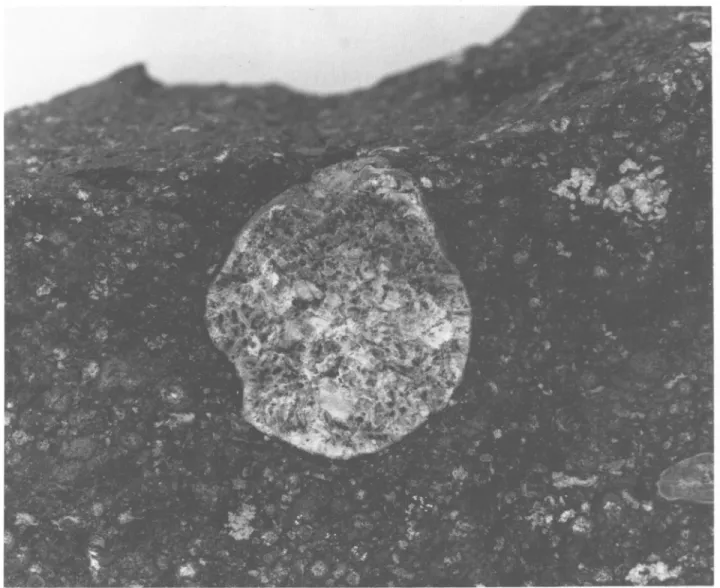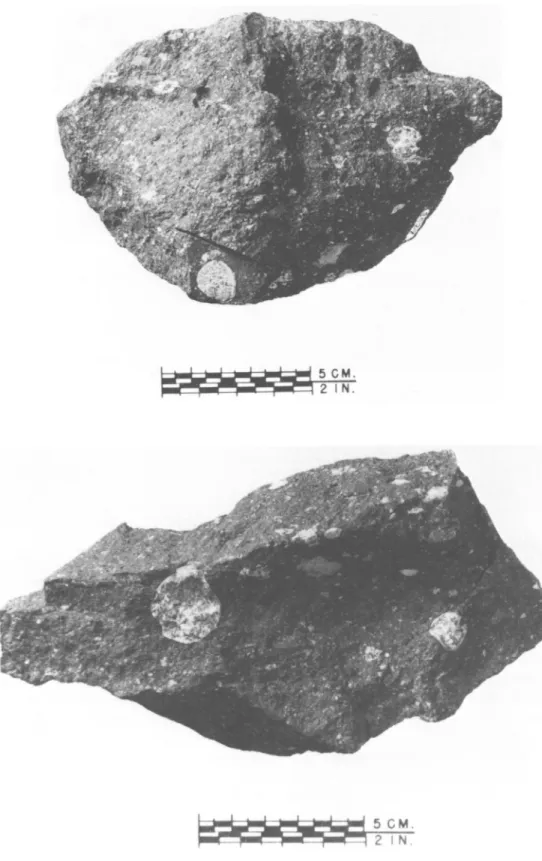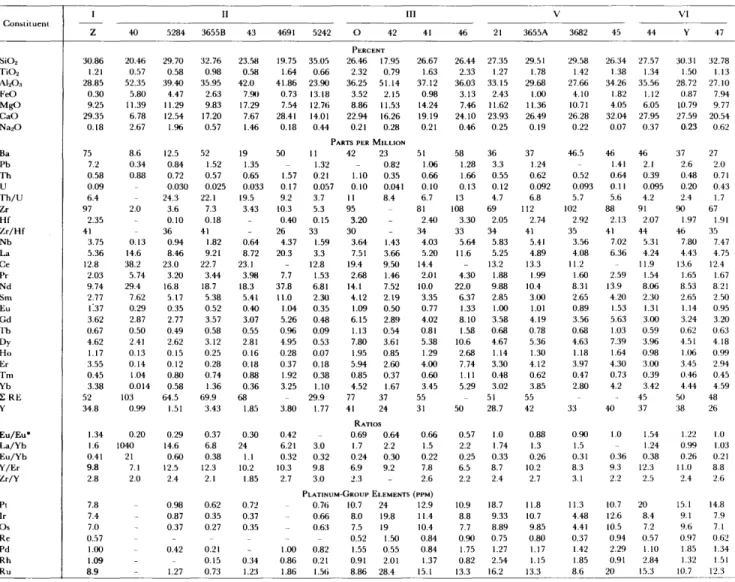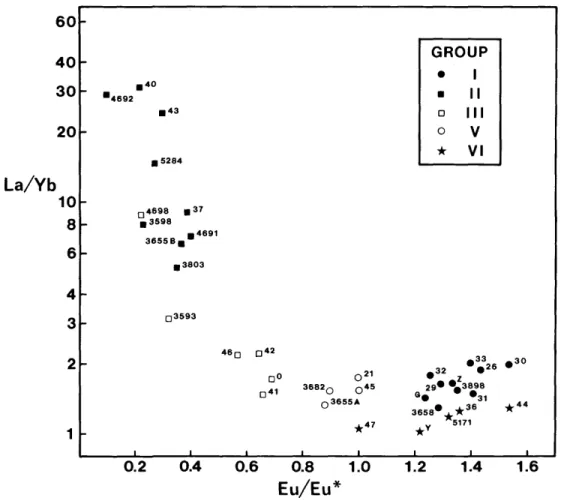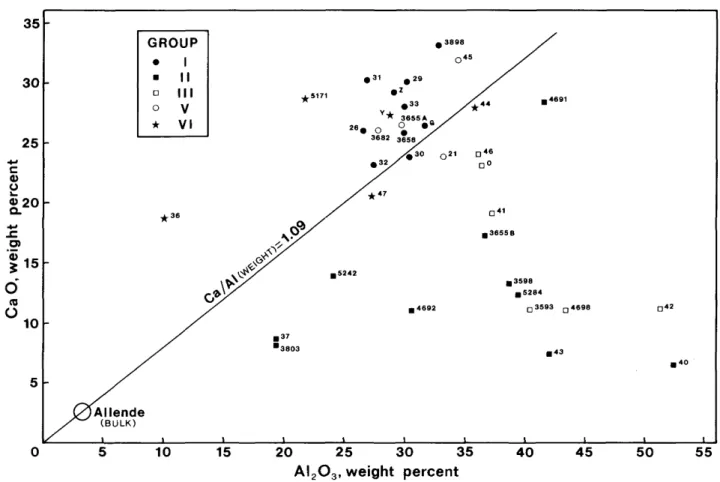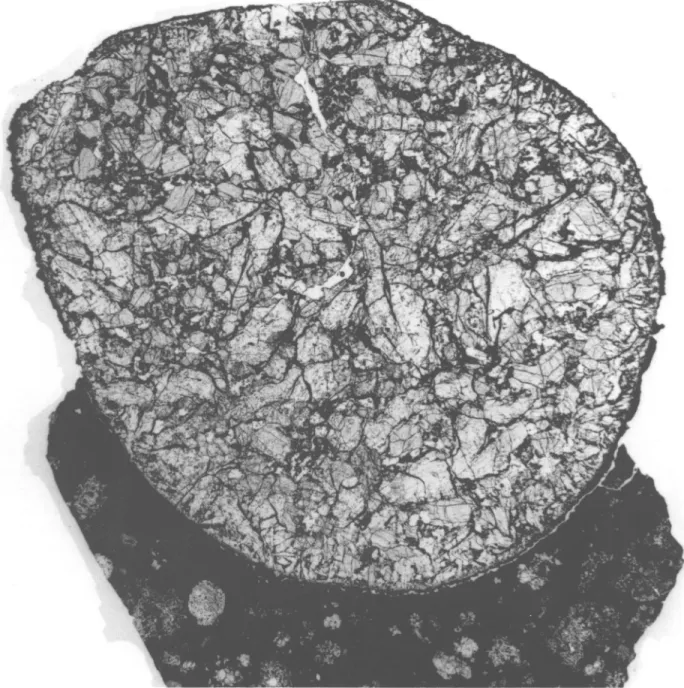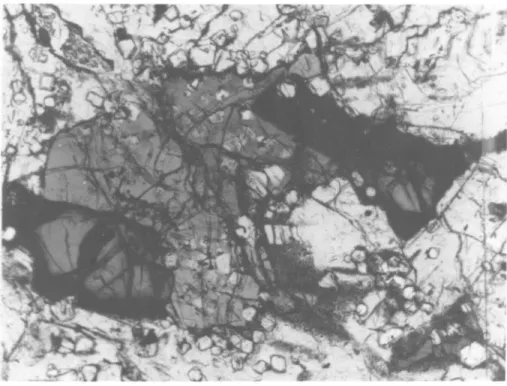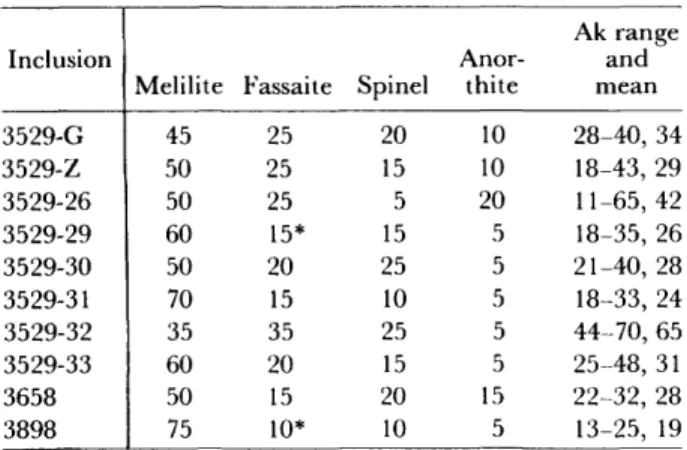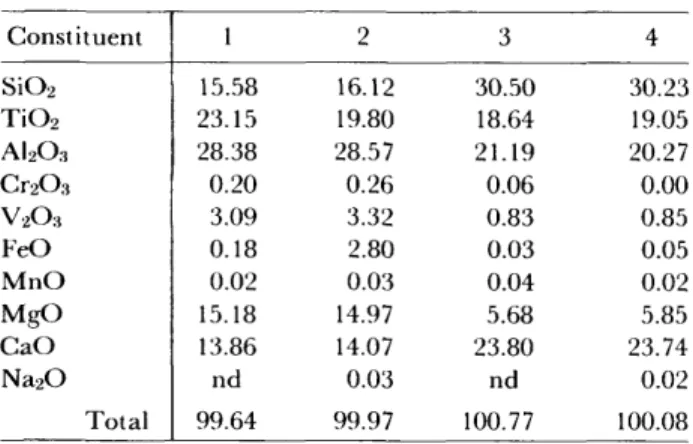Inclusions
in the Allende Meteorite
Brian Mason and S.R. Taylor
I S S U E D OCT 51982
SMITHSONIAN PUBLICATIONS
SMITHSONIAN INSTITUTION PRESS City of Washington
1982
Mason, Brian, and S.R. Taylor. Inclusions in the Allende Meteorite. Smith- sonian Contributions to the Earth Sciences, n u m b e r 25, 30 pages, 25 figures, 5 tables, 1982.—Six discrete groups of inclusions have been distinguished in the Allende meteorite. Groups I, V, and VI are mostly melilite-rich chondrules, although some have been extensively altered to fine-grained aggregates; Groups II and III are mostly fine-grained aggregates made up largely of spinel and fassaite;
Group IV are olivine-rich aggregates and chondrules. Each group has a distinctive trace-element pattern, most clearly shown by the rare-earth (RE) distribution pattern. Group I has an unfractionated pattern (except for a small positive Eu anomaly) at about 10-15 times chondrites; Group II has a highly fractionated pattern with depletion of the heavier lanthanides (Gd-Er) and negative Eu and positive Tm and Yb anomalies; Group III has an unfractionated pattern at about 20 times chondrites, except for negative Eu and Yb anomalies; Group IV has a relatively unfractionated pattern at 2-4 times chondrites; Group V has an unfractionated pattern at 10-20 times chondrites; Group VI has an unfractionated pattern at 10-20 times chondrites, except for positive Eu and Yb anomalies (i.e., complementary to Group III).
The complex patterns of trace element distribution in these Allende inclusions indicate a complex history of formation of this meteorite from the solar nebula.
OFFICIAL PUBLICATION DATE is handstamped in a limited number of initial copies and is recorded in the Institution's annual report, Smithsonian Year. SERIES COVER DESIGN: Aerial view of Ulawun Volcano, New Britain.
Library of Congress Cataloging in Publication Data Mason, Brian Harold, 1917-
Inclusions in the Allende meteorite.
(Smithsonian contributions to the earth sciences ; no. 25) Bibliography: p.
1. Allende meteorite. I. Taylor, Stuart Ross, 1925-. II. Title. III. Series.
QE1.S227 no. 25 [QB756.A44] 550s [523.5'1] 82-600091 AACR2
Contents
Page
Introduction 1 Acknowledgments 2 Experimental Methods 2 Results 3 Group I 7 Group V 12 Group III 12 Group VI 16 Group II 17 Group IV 20 Platinum-Group Elements 20 T h / U Ratios 20 La/Th Ratios 20 Zr-Hf-Y-Er 20 Unclassified CAIs 22 Discussion 24 Literature Cited 28
i n
in the Allende Meteorite
Brian Mason and S.R. Taylor
Introduction
The fall of the Allende meteorite in northern Mexico on 8 February 1969 was a unique event in the history of meteoritics. One of us (BM) was in the field immediately after the event, and even a cursory examination of the first specimens re- covered showed that the meteorite was a Type 3 carbonaceous chondrite but with components never before seen—notably giant chondrules (Fig- ure 1) which proved to have a remarkable mineral association (melilite-titanian fassaite-spinel-anor- thite) and white to pink irregular aggregates. The Smithsonian Institution field party collected about 150 kg of meteorites and distributed ma- terial to scientists in 37 laboratories in 13 coun- tries within a few weeks of the date of fall. Clarke et al. (1970) published an account of the field occurrences and gave a comprehensive account of the morphology and composition of the meteor- ite. They distinguished the following major com- ponents: (a) matrix, (b) chondrules, (c) irregular aggregates, (d) dark inclusions. The chondrules were divided into two groups on the basis of chemical and mineralogical composition: (I) Mg- rich olivine, sometimes with clinoenstatite and interstitial glass (similar to the common chon-
Brian Mason, Department of Mineral Sciences, National Museum of Natural History, Smithsonian Institution, Washington, D. C. 20560.
S.R. Taylor, Research School of Earth Sciences, Australian National University, Canberra, A.C.T., Australia 2600.
drules in Type 3 meteorites), and (II) Ca- and Al- rich chondrules (first recognized as a significant component in Allende, although a similar chon- drule had previously been described (Christophe Michel-Levy, 1968) from the Vigarano C3 chon- drite) . Chemical analyses were given of the bulk meteorite, matrix, Mg-rich chondrules, two Ca,Al-rich chondrules, a Ca,Al-rich aggregate, and a dark inclusion.
The availability of large amounts of Allende and the concurrent distribution of lunar samples resulted in extensive and intensive research on this meteorite, so that the literature on Allende now probably outweighs that on any other me- teorite. Researchers have concentrated on the Ca,Al-rich inclusions (both chondrules and ag- gregates), partly because their compositions sug- gest that they might be early condensates from solar nebula and partly because of the isotopic anomalies recognized therein (first oxygen (Clay- ton, Grossman, and Mayeda, 1973) and later other elements). Research on other components, however, has not been neglected; see, for example, publications on dark inclusions (Fruland et al., 1978) and on Mg-rich chondrules (Simon and Haggerty, 1980).
The useful acronym CAI has been widely adopted to refer collectively to Ca,Al-rich chon- drules and aggregates in Allende (and other C3 meteorites). Its use obviates the sometimes subjec- 1
FIGURE 1.—Allende 3529-G, a melilite-fassaite-spinel-anorthite chrondrule, 25 mm in diameter;
note the size contrast with the small (~1 mm) olivine-rich chondrules in the surrounding matrix.
tive judgment whether a specific inclusion crys- tallized as a molten droplet (possibly plastically deformed and/or fragmented) or originated as an aggregate of solid particles.
ACKNOWLEDGMENTS.—We thank Ms. P. Os- wald-Sealy, Mr. J.M.G. Shelley, and Mr. N. Ware for assistance in the analytical work. One of us (BM) enjoyed the hospitality of the Max-Planck- Institut fur Kernphysik and the advice and help of Dr. A. El Goresy during part of this research.
The Smithsonian Research Foundation contri-
buted part of the costs of the research, and this contribution is gratefully recorded.
Experimental Methods
A large number of Allende specimens in the collections of the National Museum of Natural History (NMNH) were inspected, and those showing prominent and readily extractable chon- drules and aggregates were selected for detailed examination. From these, over 40 chondrules and
aggregates have been extracted and subjected to complete chemical and mineralogical analysis, and many others investigated to a lesser degree.
We point out, however, that our selection was biased towards the larger and more easily ex- tracted inclusions and cannot be considered as statistically representative of the total variety of Allende inclusions. This has been clearly demon- strated by the work of Kornacki (1981). He iden- tified 189 fine- to medium-grained inclusions in 17 Allende thin sections but found none of the melilite-rich chondrules on which so much re- search has been published. Most of our inclusions were extracted from NMNH 3529, a 32-kilogram stone; in this stone, as in most Allende specimens, the inclusions are irregularly distributed, as can be seen in Figure 2. This figure shows that some pieces from a single stone may contain one or more of these large melilite-rich chondrules, whereas others have none. Each piece of Allende that we examined had many CAIs that were too small for our planned investigation.
As far as possible the CAIs were extracted from the matrix by simple mechanical tools and hand- picking to avoid introducing contaminants; how- ever, in some instances methylene iodide was used to separate the denser matrix from the less dense CAIs. Mineral identification and analysis were carried out using microscope, X-ray diffraction, and electron microprobe techniques. Composi- tional data for major elements and some minor elements were obtained by microprobe analyses of glasses prepared by fusion. The trace element data were obtained by spark source mass spec- trometry (SSMS), using the procedures described by Taylor (1965, 1971) and Taylor and Gorton (1977). The precision is about ±5% and the ac- curacy about ±5%, but they vary somewhat, being poorer for elements below mass number 105 than for those of higher mass number. Recent data show ±2% agreement with isotope dilution mass spectrometric data for Sm and Nd. Some trace elements could not be determined because their concentrations were below the sensitivity of the technique. Among the lanthanides, Lu was not determined because of its use as an internal
standard. The single mass number (169) for Tm is subject to interference from a multiple carbon ion, and this element cannot be accurately deter- mined at low concentrations (<0.3 ppm). The 169 line, however, was unexpectedly strong in Group II samples, indicating the presence of a positive Tm anomaly. The rare earth (RE) data were normalized to chondritic abundances given by Taylor and Gorton (1977).
The platinum-group elements, normally below detection limit in the SSMS technique, were ac- cessible in these samples. After extensive testing and calibration, the following mass numbers were found to provide reliable analytical data: 101Ru,
103Rh, 106Pd, 185Re, 190Os, 191Ir, and 195Pt. All other mass numbers had various interferences.
Results
The results of our chemical analyses are sum- marized in Table 1. In the discussions which follow, these results are combined with the data on 20 Allende CAIs published by Mason and Martin (1977). They determined major and mi- nor elements in 17 CAIs from the Allende mete- orite and distinguished three groups on the basis of RE distribution patterns: Group I (10 melilite- fassaite-spinel-anorthite chondrules) had unfrac- tionated chondrite-normalized RE distribution patterns at 10-15 times chondritic abundances with a positive Eu anomaly; Group II (5 aggre- gates) with La-Sm abundances similar to Group I but with rapidly diminishing abundances of the heavier RE, except for a positive Tm anomaly;
Group III (2 aggregates) with unfractionated RE abundances about 20 times those of chondrites, except for large negative Eu and Yb anomalies.
(Group IV comprised olivine-rich chondrules and aggregates with relatively unfractionated RE abundances at about three times chondrites; CaO and AI2O3 are relatively low (<10%), and hence Group IV samples are not discussed in this paper.) Taylor and Mason (1978) analyzed 18 CAIs (Table 1) and extended this classification with Group V (unfractionated RE distributions with no significant anomalies) and Group VI (RE
* .*
FIGURE 2.—Four pieces of Allende 3529, illustrating the irregular distribution of large CAI chondrules, CAI aggregates, and dark inclusions.
TABLE 1.—Analytical data on Allende CAIs by group and sample (4-digit sample numbers are NMNH catalog numbers; letters and 2-digit sample numbers are individual CAIs from NMNH 3529)
Constituent
SiO2
TiO2
AI2O, FeO MgO C a O Na2O Ba Pb Th U Th/U Zr Hf Zr/Hf Nb La Ce Pr Nd Sm Eu Gd T b Dy Ho Er Tm Yb 2 RE Y Eu/Eu*
La/Yb Eu/Yb Y/Er Zr/Y Pt Ir O s Re Pd Rh Ru
I Z 30.86
1.21 28.85 0.30 9.25 29.35 0.18 75
7.2 0.58 0.09 6.4 97
2.35 41
3.75 5.36 12.8
2.03 9.74 2.77 L37 3.62 0.67 4.62 1.17 3.55 0.45 3.38 52 34.8
1.34 1.6 0.41 9.8 2.8 7.8 7.4 7.0 0.57 1.00 1.09 8.9
40 20.46
0.57 52.35 5.80 11.39 6.78 2.67 8.6 0.34 0.88 - 2.0
- - 0.13 14.6 38.2 5.74 29.4
7.62 0.29 2.87 0.50 2.41 0.13 0.14 1.04 0.014 103
0.99 0.20 1040
21 7.1 2.0 - - - - - -
5284 29.70 0.58 39.40 4.47 11.29 12.54 1.96 12.5
0.84 0.72 0.030 24.3
3.6 0.10 3 6
0.94 8.46 23.0
3.20 16.8
5.17 0.35 2.77 0.49 2.62 0.15 0.12 0.80 0.58 64.5
1.51 0.29 14.6
0.60 12.5
2.4 0.98 0.87 0.37 _ 0.42
- 1.27
II 3655B 32.76
0.98 35.95 2.63 9.83 17.20 0.57 52
1.52 0.57 0.025 22.1
7.3 0.18 41
1.82 9.21 22.7
3.44 18.7
5.38 0.52 3.57 0.58 3.12 0.25 0.28 0.74 1.36 69.9
3.43 0.37 6.8 0.38 12.3
2.1 0.62 0.35 0.27 - 0.21 0.15 0.73
43 23.58
0.58 42.0
7.9(1 17.29 7.67 1.46 19
1.35 0.65 0.033 19.5
3.43 _ _ 0.64 8.72 23.1
3.98 18.3
5.41 0.40 3.07 0.55 2.81 0.16 0.18 0.88 0.36 68
1.85 0.30 24
1.1 10.2 1.85 0.72 0.37 0.35 - - 0.34 1.23
4691 19.75 1.64 41.86 0.73 7.54 28.41 0.18 50
- 1.57 0.17 9.2 10.3 0.40 26
4.37 20.3
_ 7.7 37.8 11.0 1.04 5.26 0.96 4.95 0.28 0.37 1.92 3.25 _ 3.80 0.42 6.21 0.32 10.3
2.7 - -
1.00 0.86 1.86
5242 35.05 0.66 23.90 13.18 12.76 14.01 0.44
O 42
PERCENT 26.46
2.32 36.25 3.52 8.86 22.94 0.21
17.95 0.79 51.14 2.15 11.53 16.26 0.28 PARTS PER MILLION 11
1.32 0.21 0.057 3.7 5.3 0.15 33
1.59 3.3 12.8 1.53 6.81 2.30 0.35 0.48 0.09 0.53 0.07 0.18 0.38 1.10 29.9
1.77 _ 3.0 0.32 9.8 3.0
42 _ 1.10 0.10 11 95 3.20 30
3.64 7.51 19.4
2.68 14.1
4.12 1.09 6.15 1.13 7.80 1.95 5.94 0.85 4.52 77 41
23 0.82 0.35 0.041 8.4
- _ _ 1.43 3.66 9.50 1.46 7.52 2.19 0.50 2.89 0.54 3.61 0.85 2.60 0.37 1.67 37 24 RATIOS 0.69
1.7 0.24 6.9 2.3
0.64 2.2 0.30 9.2
- III
41 26.67
1.63 37.12 0.98 14.24 19.19 0.21 51
1.06 0.66 0.10 6.7 81
2.40 34
4.03 5.20 14.4
2.01 10.0
3.35 0.77 4.02 0.81 5.38 1.29 4.00 0.60 3.45 55 31 0.66
1.5 0.22 7.8 2.6 PLATINUM-GROUP ELEMENTS (PPM)
0.76 0.66 0.63 _ 0.82 0.21 1.56
10.7 8.0 7.5 0.52 1.55 0.91 8.86
24 19.8 19
1.50 0.55 2.01 28.4
12.9 11.4 10.4 0.84 0.84 1.37 15.1
46 26.44
2.33 36.03 3.13 7.46 24.10 0.46 58
1.28 1.66 0.13 13 108 3.30 33
5.64 11.6
_ 4.30 22.0
6.37 1.33 8.10 1.58 10.6
2.68 7.74 1.11 5.29 _ 50
0.57 2.2 0.25 6.5 2.2 10.9 8.8 7.7 0.90
1.75 0.82 13.3
21 27.35
1.27 33.15 2.43 11.62 23.93 0.25 36
3.3 0.55 0.12 4.7 69
2.05 34
5.83 5.25 13.2
1.88 9.88 2.85 1.00 3.58 0.68 4.67 1.14 3.30 0.48 3.02 51 28.7
1.0 1.74 0.33 8.7 2.4 18.7 9.33 8.89 0.75 1.27 2.54 16.2
V 3655A
29.51 1.78 29.68 1.00 11.36 26.49 0.19 37
1.24 0.62 0.092 6.8 112
2.74 41
5.41 4.89 13.3
1.99 10.4
3.00 1.01 4.19 0.78 5.36 1.30 4.12 0.62 3.85 55 42 0.88 1.3 0.26 10.2
2.7 11.8 10.7 9.85 0.80 1.17 1.15 13.3
3682 29.58 1.42 27.66 4.10 10.71 26.28 0.22 46.5
0.52 0.093 5.7 102
2.92 35
3.56 4.08 11.2
1.60 8.31 2.65 0.89 3.56 0.68 4.63 1.18 3.97 0.47 2.80 - 3 3
0.90 1.5 0.31 8.3 3.1 11.3 4.48 4.41 0.37 1.42 1.85 8.6
45 26.34
1.38 34.26 1.82 4.05 32.04 0.07 46
1.41 0.64 0.11 5.6 88
2.13 41
7.02 6.36 - 2.59 13.9
4.20 1.53 5.63 1.03 7.39 1.64 4.30 0.73 4.2
- 40
1.0 - 0.36 9.3 2.2 10.7 12.6 10.5 0.94 2.29 0.91 20
44 27.57
1.34 35.56 1.12 6.05 27.95 0.37 46
2.1 0.39 0.095 4.2 91
2.07 44
5.31 4.24 11.9
1.54 8.06 2.30 1.31 3.00 0.59 3.96 0.98 3.00 0.39 3.42 45 37 1.54 1.24 0.38 12.3
2.5 20
8.4 7.2 0.57
1.10 2.84 15.3
VI Y 30.31
1.50 28.72 0.87 10.79 27.59 0:23 37
2.6 0.48 0.20 2.4 90
1.97 4 6
7.80 4.43 13.6
1.65 8.53 2.65 1.14 3.24 0.62 4.51 1.06 3.45 0.46 4.44 50 38 1.22 0.99 0.26 11.0
2.4 15.1 9.1 9.6 0.97
1.85 1.32 10.7
47 32.78
1.13 27.10 7.94 9.77 20.54 0.62 27
2.0 0.71 0.43 1.7 67
1.91 3 5
7.47 4.75 12 A
1.67 8.21 2.50 0.95 3.20 0.63 4.18 0.99 2.94 0.45 4.59 4 8 26
1.0 1.03 0.21 8.8 2.6 14.8 7.9 7.1 0.62 1.34 1.51 12.3
patterns the reciprocal of Group III, about 15 times chondrites with positive Eu and Yb anom- alies). They noted, however, that major and trace- element distributions for Groups I, III, V, and VI show many similiarities. The application of this RE classification is illustrated in Figure 3. The CAIs clearly cluster in discrete groupings; the only discrepancy is 4698, a Group III inclusion which plots among the Group II inclusions be- cause of an anomalously low Yb content.
Since the CAIs are characterized by their high Ca and Al contents, it is of interest to examine
this relationship in detail, especially since Ahrens and von Michaelis (1969) have shown that the Ca/Al ratio (by weight) is almost constant at 1.09 in chondrites and many achondrites. This rela- tionship for the Allende CAIs is shown in Figure 4; the point for Allende (bulk) falls on the 1.09 line, but the points for the individual CAIs scatter widely. The points for Groups I, V, and VI cluster fairly closely above or just below the 1.09 line (except 36, which has a unique mineralogy con- sisting largely of andradite). Group II and III CAIs plot below and generally well away from
60h 40 30 20[-
La/Yb
10 8 6 4 3 2h
1 - -
•4 0 B4692
B4 3 -
B5284
n4698 «37
B3598 -4691 3 6 5 5 BB"
B3803
D3593
46 D D4 2
D°
D41
i I •
O21 3 6 8 2Q Q4 5
O3655A
• 4 7 I 1
GROUP
•
•
o
•
•
3 6 5 8 * i
1
II III V VI
3 3
Z
171
0.2 0.4 0.6 0.8 1.0
Eu/Eii*
1.2 1.4 1.6
FIGURE 3.—Plot (semi-log) of La/Yb ratio vs. Eu/Eu* (europium anomaly) for Allende CAI groups (omitting Group IV) (4-digit sample numbers are NMNH catalog numbers; G, O, Y, Z, and 2-digit sample numbers are individual CAIs from NMNH 3529).
the 1.09 line and show a much wider range of Ca and Al contents than the other groups. The in- dividual groups will now be discussed in detail.
GROUP I
Group I CAIs appear to be relatively restricted in chemical and mineralogical composition (Fig- ures 3, 4) and are readily identified since they are all coarse-grained (grain size 0.5-3 mm) chon- drules consisting largely of melilite and titanian fassaite, with minor amounts of spinel and anor- thite (Figure 5). Ten have been chemically ana- lyzed, of which the data on nine (3529-26, 29, 30, 31, 32, 33, G; 3658; 3898) were reported by Mason and Martin (1977), and for the tenth
(3529-Z) the analytical data are given in Table 1 (5171, which was reported as a Group I CAI by Mason and Martin (1977) has been reclassified as Group VI). The RE data are summarized in Figure 6 for minimum (3529-31), average of 10, and maximum (3529-Z) values. RE data on CAIs by Gast, Hubbard, and Wiesmann (1970) and by Wanke et al. (1974) fall within the range of these Group I inclusions.
The mineralogical composition of the Group I inclusions is also relatively uniform. The data in Table 2 have been derived from microscopic ex- amination of thin sections, microprobe analyses of the minerals, and the bulk compositions in Table 1. The principal variable in the mineral- ogical composition is the amount and composi-
35
30
25 c a>
o a>20 a.
4-»
O)
| 1 5
o
(0o
105 -
_
GROUP
• 1
• II a I I I o v
• VI -
_
*3 6
-
/ /
0Allende
/ ^ (BULK) S 1 I
,3898 / O45 / ,31 ,29 /
• 5171 # Z -3 X T B4««1
v* * / *
* 3655Ae >^
3682 3658 x ^
/ ^ O Q21 D46
• 32 / DO
/ D41
. O / ,3655B
\^X B5242
• « ^ \ / B5284
/ B4 6 9 2 D3593 Q 4698 D4 2
. 3 7
B3803 4 3
, 4 0
1 1 1 1 1 1 1 1 1
10 15 20 25 30 35 AI2O3, weight percent
4 0 4 5 5 0 55
FIGURE 4.—The relationship between CaO and AI2O3 in individual samples (sample identifications as in Figure 3).
tion of the melilite. The pyroxene is highly alu- minous (AI2O3, 16%-22%) and titanian (TiO2, 3.9%—19.1%); a detailed account of these pyrox- enes was published by Mason (1974). Spinel and anorthite have compositions close to stoichiomet- ric MgAl2O4 and CaAl2Si2O8. Melilite shows al- teration along grain boundaries to a fine-grained material consisting largely of grossular, sometimes with minor nepheline; these minerals probably contain the minor amounts of FeO and Na2O shown by the bulk analyses.
Two of these Group I inclusions (3529-29, 3898) contain minor amounts (<5%) of rhonite, whose unit-cell formula is Ca4Xi2(Si, Al)i2O40, where X includes Mg, Fe, Ti, and Al. Rhonite and fassaite in 3529-29 are illustrated in Figure 7, and micro- probe analyses of these minerals are given in Table 3. Rhonite in Allende CAIs is distinctly
different from terrestrial rhonite in its high con- tent of Al, Ti, and V and its low Si and Fe content. The high vanadium content is especially remarkable, since the content of this element in the bulk meteorite (90 ppm) is not exceptional.
In meteoritic rhonite and fassaite the titanium is evidently present as both Ti3 and Ti4 (Dowty and Clark, 1973; Fuchs, 1978). In the formulas cal- culated from the analyses in Table 3, the titanium is arbitarily calculated as equal amounts of Ti3
and Ti4; this procedure results in excellent agree- ment with the structural formulas.
Figure 7 shows that the rhonite is rimmed and veined by black opaque material. This material has been described as a fassaite-spinel-perovskite symplectite by Haggerty (1977) and El Goresy, Nagel, and Ramdohr (1977). Haggerty interprets this symplectite as a decomposition product of
FIGURE 5.—Microphotograph (transmitted light) of 3529-G, a Group I melilite-rich chondrule 25 mm in diameter; melilite is present as large prismatic crystals, fassaite and anorthite occur as equant grains interstitial to the melilite, and spinel is disseminated as small grains throughout the other minerals.
rhonite, whereas El Goresy and his coworkers infer simultaneous precipitation of fassaite + per- ovskite from a silicate liquid around pre-existing rhonite and spinel. The Ca and Ti are present in rhonite in the correct proportions to produce
perovskite in considerable amounts; some CAIs show patchy concentrations of perovskite grains suggestive of pre-existing rhonite.
Haggerty (1977:389) stated: "These cores (of rhonite) are unquestionably the earliest constitu-
La Ce Pr Nd Sm Eu Gd Tb Dy Ho Er Tm Yb
FIGURE 6.—RE distribution patterns for Group I CAIs (31 = minimum RE concentrations, Av = average of 10 Group I CAIs, Z = maximum RE concentrations).
FIGURE 7.—Allende 3529-29: rhonite (darker gray, black borders) and fassaite (lighter gray) enclosed in melilite; idiomorphic spinel grains, average 0.05 mm, are present in melilite and fassaite.
TABLE 2.—Mineralogical composition of Group I inclusions (estimated weight percentages of minerals; range and mean Ak content of melilite)
Inclusion 3529-G 3529-Z 3529-26 3529-29 3529-30 3529-31 3529-32 3529-33 3658 3898
Melilite 45 50 50 60 50 70 35 60 50 75
Fassaite 25 25 25 15*
20 15 35 20 15 10*
Spinel 20 15 5 15 25 10 25 15 20 10
Anor- thite
10 10 20 5 5 5 5 5 15 5
Ak range a n d mean 28-40, 34 18-43, 29 11-65, 42 18-35, 26 21-40,28 18-33, 24 44-70, 65 25-48, 31 22-32, 28 13-25, 19
* Includes rhonite.
ent in the CAT (Ca-Al-Ti-rich inclusion)." Our observations suggest the reverse, that rhonite was the last mineral to crystallize. The sequence of crystallization appears to be spinel-melilite-fas- saite-rhonite. As Clarke et al. (1970:39) pointed out, the sequence spinel-melilite-fassaite is that predicted from studies of crystallization of melts in the CaO-MgO-Al2O3-SiO2 systems and is sup- ported by textural relations in the melilite-rich chondrules, in which small euhedral crystals of spinel are included within all the other minerals;
melilite is present as large zoned crystals (indicat- ing crystallization over a considerable tempera- ture interval), whereas fassaite occurs as smaller xenomorphic grains in the interstices of the mel- ilite crystals. These relations are present in 3529- 29 and 3898, with the rhonite enclosed in the fassaite. The extreme enrichment of Ti and V in the rhonite probably represents a concentration of these elements in the residual liquid after practically all the material of the chondrule had crystallized as spinel and melilite, both essentially free of these elements. Boivin (1980) has demon- strated that in terrestrial rocks rhonite is a late- crystallized phase, after spinel and pyroxene.
Data on some of these Group I inclusions have been reported in the literature. The 39Ar-40Ar systematics of 3529-Z have been studied by Her-
zog et al. (1980), who find it contains excess 40Ar over that produced by in situ decay of 40K. Nie- meyer and Lugmair (1980) report the Ti isotopic composition in this inclusion. Jessberger et al.
(1980) have published K-Ar data on 3529-26. El Goresy et al. (1979) have reported a number of accessory phases in "Fremdlinge" in 3529-29, in- cluding a calcium phosphate containing Mo and Ru, and Fe- and V-rich oxides; in this inclusion Jessberger et al. (1980) have reported K-Ar data, El Goresy and Ramdohr (1980) have reported Os depletion in "Fremdlinge," and Jordan et al.
(1980) have found an unusual Xe isotopic com- position. Mason and Martin (1974) separated melilite and pyroxene from 3529-32 and analyzed these minerals for major, minor, and trace ele- ments; they recorded high contents of Mo and the Pt elements (except Pd) in both minerals and suggested that these elements were present as minute grains of native metal, a suggestion that
TABLE 3.—Rhonite and fassaite compositions in Allende inclusions (nd = not determined)
Constituent SiO2
TiO2
AI2O3
Cr2O3
v
2o
3F e O M n O M g O C a O Na2O
Total 1
15.58 23.15 28.38 0.20 3.09 0.18 0.02 15.18 13.86 nd 99.64
2 16.12 19.80 28.57 0.26 3.32 2.80 0.03 14.97 14.07 0.03 99.97
3
30.50 18.64 21.19 0.06 0.83 0.03 0.04 5.68 23.80 nd 100.77
4
30.23 19.05 20.27 0.00 0.85 0.05 0.02 5.85 23.74 0.02 100.08 Column 1: Rhonite, 3529-29; calculated formula
Ca3.88 (Mgr,.91 Ti'$2.27Ti42.27 Alo.79 Vo.6f>- Column 2: Rhonite, 3898; calculated formula
Ca3.95 (Mg5.85 Ti3i.95Ti4i.95 AI1.03 V0.70 Feo.6i)- (Si4.23Al7.97)O40
Column 3: Fassaite, 3529-29; calculated formula Cao.97(Mgo.32Ti 0.27Ti 0.27AI0.11V0.03)-
(Sii.i6Al0.84)O6
Column 4: Fassaite, 3898; calculated formula Cao.98 (Mgo.MTi' 0.27 Ti 0.27 Alo.07 V0.03)- (Sii.i6Al0.84)O6
has since been confirmed. Wark and Lovering (1980) have provided a detailed petrographic description of 3529-33, including the minute metal grains rich in Pt-group elements; this inclu- sion (identified as Dl) was analyzed by Gray, Papanastassiou, and Wasserburg (1973), who showed that it had a very low 87Sr/86Sr ratio;
Jessberger et al. (1980) have published K-Ar data.
Material from 3898 (their D7) was analyzed by Gray, Papanastassiou, and Wasserburg (1973), who reported compositions of melilite and pyrox- ene, contents of Rb and Sr, and 87Sr/86Sr ratios;
Rb is extremely low (0.01-0.02 ppm) and 87Sr/
Sr is the lowest yet measured, identifying this material as a very early condensate from the solar nebula. Niederer, Papanastassiou, and Wasser- burg (1980) found Ti isotope anomalies, and Becker and Epstein (1981) consider it a FUN inclusion (inclusions showing isotopic fractiona- tion (F) and unidentified nuclear (UN) effects),
48, 17/
anomalous in Ca, O, and O.
GROUP V
Group V inclusions were distinguished by Tay- lor and Mason (1978) on the basis of their RE distribution pattern, which is essentially unfrac- tionated with no significant anomalies (Figure 8).
Four such inclusions have been recognized, and their mineralogical compositions are given in Table 4. In major-element chemistry and in min- eralogical composition and texture they are prac- tically indistinguishable from Group I inclusions.
TABLE 4.—Mineralogical composition of Group V inclusions (estimated weight percentages of minerals; range and mean Ak content of melilite)
Inclusion 3529-21 3529-45 3655A 3682
Melilite
30 70 30 40
Fassaite 40 20 50 40
Spinel 20 10 10 10
Anor- thite
10 0 10 10
Ak range and mean 17-47, 33
4-15, 9 12-56, 24 20-43, 26
Inclusion 3529-45 does have some unique fea- tures; it consists largely of Al-rich melilite (note the low Ak content given in Table 4), and the fassaite is associated with small areas of inter- grown perovskite, spinel, and hibonite (Figure 9)—this mineral association is highly suggestive of decomposed rhb'nite. Minor and trace element concentrations (Table 1) are similar to those in Group I inclusions.
Steele and Hutcheon (1979) have published an Al-Mg isochron determined by ion microprobe on coexisting spinel, melilite, and hibonite in 3529-45. Herzog et al. (1980) have reported min- eral compositions and 39Ar-40Ar systematics on 3655A.
GROUP III
Group III inclusions are characterized by an unfractionated RE distribution pattern at 10- 40 times chondrites, except for negative Eu and
50
- (A - 0)
h oc - O
• 3655-A o 3529-21
• 3682
• 3529-45
La Ce Pr Nd Sm Eu Gd Tb Dy Ho Er Tm Yb
FIGURE 8.—RE distribution patterns for Group V Allende CAIs.
FIGURE 9.—Spinel (cubes)-hibonite (laths)-perovskite (white) intergrowth in Allende 3529-45 (reflected light); this association suggests an origin by the decomposition of rhonite.
Yb anomalies of equal magnitude (Figure 10).
The first pattern of this kind was described by Tanaka and Masuda (1973); this was determined on a portion of 3529-O. Mason and Martin (1977) described two Group III inclusions (3593 and 4698). We have studied four Group III inclusions, and their mineralogical compositions are given in Table 5. In major-element composition they are similar to Group I inclusions, except for higher
TABLE 5.—Mineralogical composition of Group III inclu- sions (estimated weight percentages of minerals; range and mean Ak content of melilite)
Inclusion 3529-O 3529-41 3529-42 3529-46
Melilite 40 30 40 55
Fassaite 40 30 15 20
Spinel 20 20 35 20
Anor- thite
0 20 10 5
Ak range a n d mean 25-40, 35 22-39, 30 1-4, 3 3-12, 6
AI2O3 and lower CaO contents. Group III inclu- sions, however, show a variety of textural rela- tionships, from coarse-grained chondrule-like ob- jects to fine-grained irregular aggregates; some show complex internal rimming associated with the alteration of melilite to grossular (Figure 11).
Inclusion 3529-42 has areas extremely rich in hibonite (Figure 12); inclusion 3529-46 has areas rich in perovskite, suggestive of the decomposition of rhonite (Figure 13).
Minor and trace element concentrations in Group III inclusions (Table 1) are generally sim- ilar to those in Group I inclusions (except for the Eu and Yb anomalies).
Lorin and Christophe Michel-Levy (1978) have described metal grains, vanadium oxide inclu- sions, and Mg isotopic anomalies in 3529-42.
Wark (1981a) has published analyses of nephe- line, sodalite, anorthite, spinel, grossular, andrad- ite, and pyroxene from 3593 and estimated its primary and altered composition.
5 0
2 0
10
• 3529-0
• 3529-42 D 3529-41
• 3529-46
La Ce Pr Nd Sm Eu Gd Tb Dy Ho Er Tm Yb FIGURE 10.—RE distribution patterns for Group III Allende CAIs.
FIGURE 11.—Photomicrograph (transmitted light) of Allende 3529-46, a Group III CAI, consisting largely of melilite (white) and spinel, the melilite much altered to grossular
(gray, fine-grained). Note extensive internal rims.
FIGURE 12.—Photomicrograph (reflected light) of a portion of Allende 3529-42, a Group II CAI, showing hibonite (laths) and spinel (cubes) in melilite.
FIGURE 13.—Photomicrograph (reflected light) of a portion of Allende 3529-46, showing a concentration of perovskite (white, grains ~ 2-4 micrometers).
GROUP VI
Group VI inclusions were characterized by Taylor and Mason (1978) as having flat RE distribution patterns except for positive Eu and Yb anomalies (Figure 14). These patterns are complementary to those of Group III, although the Eu and Yb anomalies are not so pronounced in the Group VI inclusions. Inclusions 5171 and
3529-36, described in Mason and Martin (1977) as Group I and unclassified, should also be in- cluded in Group VI. Group VI inclusions show a wide range in chemical and mineralogical com- positions and in textures. Inclusion 3529-Y is a melilite-rich chondrule, quite similar to the nu- merous Group I chondrules, as is inclusion 5171.
Inclusion 3529-44 is an irregular medium-grained white inclusion (possibly a deformed chondrule)
5 0
- CO
h oc
- O
o 3529-Y
• 3 5 2 9 - 4 4
La Ce Pr Nd Sm Eu Gd Tb Dy Ho Er Tm Yb
FIGURE 14.—RE distribution patterns for Group VI Allende CAIs.
FIGURE 15.—Photomicrograph (transmitted light) of Allende 3529-47, a Group VI CAI, showing melilite (white) largely altered to grossular-andradite (gray, fine-grained) and rimmed by diopside.
•^w. x, 3^ " * Plte
FIGURE 16.—Photomicrograph (transmitted light) of Allende 3529-36, a Group VI CAI, showing andradite (dark gray to black) with lighter areas of nepheline, sodalite, and melilite.
consisting largely of melilite (mean composition AIC27) which is extensively altered to grossular.
Inclusion 3529-47 is an unzoned aggregate, 15 mm in maximum dimension, consisting largely of gehlenitic melilite (mean composition Ak3); the melilite is extensively altered to grossular or an- dradite and is rimmed by diopside (Figure 15).
Inclusion 3529-36 is a large rounded aggregate, possibly a deformed and altered chondrule; it is unique in Allende inclusions so far examined in consisting largely of andradite (Figure 16), possi- bly pseudomorphous after melilite or fassaite.
Except for the Eu and Yb anomalies, the trace- element concentrations in Group VI inclusions are similar to those in Group I inclusions.
Becker and Epstein (1981) have reported a 29Si deficiency in 3529-Y.
GROUP II
Group II inclusions show a highly fractionated RE distribution pattern, characterized by the light RE (La-Sm) at 10-50 X chondrites, a neg-
ative Eu anomaly, a very rapid decline in relative abundances from Gd to Er, a strong positive Tm anomaly (Tm — Sm), and Yb abundance com- parable with that for Eu (Figure 17). This pattern was first recognized by Tanaka and Masuda (1973) in their Allende inclusion G (inclusion 3598 in Mason and Martin (1977)). Mason and Martin described five Group II inclusions, and we have found five more (Table 1).
All the Group II inclusions except one are fine- grained (average grain size 0.01-0.04 mm) irreg- ular aggregates (Figure 18), white to pink (the pink color usually indicates a richness in spinel).
The exception is 4691, a large irregular inclusion (maximum dimension 15 mm) consisting largely of melilite (Ak5_i2, average Ak7) with abundant spinel inclusions, and a little fassaite and anor- thite (Figure 19). Group II inclusions show a wide range in major-element composition (Table 1 and Figure 4); most of them show relatively high alkali and FeO contents (Na2O up to 4.7%, FeO up to 13%). The wide range in major-element composition is reflected in a wide range in min-
50 -
20 -
10 -
5 -
2 -
1 -
.5 - I a
• * • i
ites
- o
- .c
~ a>
- a.
" (0E
CO
-
-
O D-___
^ 3529-40 1 o 3655-B
• 3529-43 a 4691
• 5242
* 5284
H
t \
/H I\
f \ I X
\ \ \ /# \\
1 1 1 1 1 1 1 I
La Ce Pr Nd Sm Eu Gd Tb Dy Ho Er Tm Yb
FIGURE 17(upper).—RE distribution patterns for Group II Allende CAIs.
FIGURE 18(right).—Photomicrograph of Allende 3529-37, a fine-grained Group II CAI, consisting of fine-grained melil- ite, fassaite, and spinel, with some nepheline and sodalite;
black material is fine-grained matrix.
eralogical composition. Modal composition can- not be precisely determined because of the fine- grained nature of these inclusions; microscopic examination, X-ray diffraction, and microprobe data show that the minerals include major mel- ilite, fassaite, and spinel, minor nepheline and sodalite and possibly anorthite, and accessory perovskite and hibonite; grossular and grossular- andradite are usually present, possibly as altera- tion products of melilite. Figure 20 illustrates the texture of a typical fine-grained Group II inclu- sion, as revealed in the scanning electron micro- scope. It is markedly porous and consists of an aggregate of jUm-sized anhedral mineral grains,
FIGURE 19.—Photomicrograph (transmitted light) of Allende 4691, a coarse- grained Group II CAI, consisting of melilite (white) enclosing innumerable micrometer-sized spinel grains; dark material is surrounding matrix.
FIGURE 20.—Scanning electron micrograph of Allende 4692, a fine-grained Group II CAI; white is largely spinel and pyroxene, with some hibonite; gray is nepheline and sodalite, black is pore space.
sometimes aggregated into chains; the whole ap- pearance is suggestive of a flocculated mass of dust particles.
As well as their characteristic RE patterns, Group II inclusions are distinctly different from other GAIs in other trace elements. They are relatively depleted in Y, Zr, Hf, Nb, and the platinum-group elements.
Niederer, Papanastassiou, and Wasserburg (1981) have published Ti isotopic data, and Chen and Wasserburg (1981) report on U-Pb isotopic compositions in 3529-40. For 4691 Wark (1981b) has estimated primary and altered compositions;
Jessberger et al. (1980) have published K-Ar data;
and Niemeyer and Lagmair (1980) have reported Ti isotopic compositions.
GROUP IV
We have no data on Group IV inclusions be- yond those published by Mason and Martin (1977). As mentioned previously, these olivine- rich inclusions are relatively low in Ca and Al and on that account should perhaps be excluded from the CAIs.
PLATINUM-GROUP ELEMENTS
(Data from Table 1 only)
Although the RE have proven most useful in distinguishing among the various classes of Al- lende inclusions, other trace elements show some characteristic differences. The Group II inclusions contain abundances of Ru, Rh, Pd, Os, Ir, and Pt at about chondritic levels (our analytical tech- nique was not sensitive enough to detect Re at this level).
In contrast, Groups I, III, V, and VI are en- riched in the refractory trace elements Ru, Re, Os, Ir, and Pt at 10-20 times chrondritic levels.
They show a relative depletion in Rh (5 X Cl abundances) and particularly in Pd (2-3 X Cl abundances) (Figure 21). There is a good corre- lation between the relative abundances and the condensation temperatures for these elements in Groups I, III, V, and VI (Figure 22). Thus the element fractionations are clearly linked to rela-
tive volatility. It is curious that the Group II inclusions show about chondritic levels of the Pt- group elements, despite the evidence of extreme fractionation evident in the RE patterns.
T H / U RATIOS (Data from Table 1 only)
The analytical data for these elements are both precise and accurate by the SSMS technique.
Wide variations among the ratios are found among the inclusions (Table 1). Only in Group VI is the ratio chondritic (3.8) or below. Groups I, III, and V have ratios ranging from 4.7-13 with little overlap between the groups. One Group II inclusion (5242) has a chondritic ratio, but the others show values up to 24.3. This variation is attributed mainly to changes in the abundance levels of uranium relative to the more refractory element thorium.
L A / T H RATIOS (Data from Table 1 only)
Thorium appears to behave in a very similar manner to the light RE, La, in Groups I, III, V, and VI. The La/Th ratio is 8.50 ± 1.45, which is essentially equivalent to the chondritic ratio of 8.51. The correlation coefficient (r) for 12 samples is 0.963, illustrating that there is no fractionation between these elements. In contrast, the Group II inclusions (6 samples) have La/Th = 13.50 ± 1.5, with a correlation coefficient of 0.969. In these inclusions La is thus enriched uniformly over Th by a factor of 1.6.
ZR-HF-Y-ER (Data from Table 1 only)
The extreme behavior of Er in the Group II inclusions makes it of interest to identify other
FIGURE 21 (upper).—Platinum-group element distribution patterns in Allende CAIs.
FIGURE 22(lower).—Correlation between relative abun- dances and condensation temperatures for platinum-group elements in Allende CAIs.
0.1
Ru Rh Pd Re Os Ir Pt
30 _
'—• 10 I
o
O
E o.
a
£ a a
1.0
1
-
IIIIIiii i
i
i i
Pt
4
Pd
i
i i
i
R u
<
I
i
-
> <
Ir
i
i
O s
I I I I 1I ill
i
1000 1500 2000
Condensation Temperature K
elements showing similar characteristics. The par- allel behavior of Y to the heavy RE in many geochemical processes also makes it useful to com- pare its distribution in the Allende inclusions. In Groups I, III, V, and VI, Y correlates with the heavy RE, since they have patterns parallel to those of chondrites. In Group II, Y correlates with Er but not with neighboring Ho or Tm. Accord- ingly, Y and Er must have similar volatilities.
The Y/Er ratio is constant at 9.4 ± 1.8 for all inclusions. The correlation coefficient r=0.945 for 18 samples. The chondritic ratio for Y/Er is 9.39, and, accordingly, yttrium and erbium show a closely coherent relationship during cosmochem- ical processes.
Other elements which show a close correlation with Y and Er are Zr and Hf. Zr/Y is constant for all inclusions at 2.34 ± 0.30. Our Zr data by SSMS are less precise than those for Hf, but the Zr/Hf ratio is 36 ± 4.9 for all inclusions. This value is not distinguishable from the chondritic ratio of 33, the difference being due to the less precise nature of our Zr values. Accordingly, these four elements must have similar volatility char- acteristics and remain locked together in cosmo- chemical processes.
UNCLASSIFIED C A I S
We have found some CAIs, and others have been described in the literature, that appear to be different from any of those described above.
Unfortunately, for most of them no RE data are available.
Inclusion 3509 is a chalky-white chondrule, 8 mm in diameter (Figure 23). It was found in one of the first Allende specimens collected and was described by Clarke et al. (1970:39), as follows:
A single chondrule of type c has been found. It was observed on a broken fragment of the meteorite, being unusually large (8 mm in diameter) and a uniform chalky-white color. It is so fine-grained that the individual minerals could not be identified in grain mounts in immersion oils. X-ray powder photographs provided positive identification for sodalite, nepheline, clinopyroxene (probably fassaite), and olivine, and this mineralogy is consistent with the bulk chemical composition of the chondrule (Table 3, column 8). By the X-ray procedure of Yoder and Sahama (1957) the compo-
sition of the olivine was found to be Fa26, in good agreement with the FeO/(FeO+MgO) ratio in the chemical analysis.
This occurrence of sodalite (NasAleSieC^C^, with 7.3 per- cent Cl), the first recorded from a meteorite, is particularly intriguing, since the chlorine content of stony meteorites is usually low (of the order of 100 ppm) and combined as chlorapatite. Microprobe analyses have confirmed the pres- ence of nepheline and sodalite, and have provided some significant compositional data; in particular, potassium is notably fractionated between the two minerals, the nephe- line containing 1.5 percent K and the sodalite less than 0.1 percent. The extremely fine-grained texture of this chondrule suggests that it solidified as a glass and subsequently devi- trified.
Grossman and Steele (1976:150) commented that
"Clarke et al. (1970) gave a very accurate descrip- tion of an amoeboid aggregate but they classified it as a type c Ca-Al-rich chondrule" [their italics].
Since they never saw the specimen, their reclas- sification of it as an amoeboid aggregate is evi- dently based on their interpretation of the above description; however, this inclusion is certainly not amoeboid.
The phase composition, estimated from the chemical analysis and the minerals present, is (weight percent): olivine (Fa26) 35, nepheline 30, sodalite 20, pyroxene 15. Mason and Martin (1977) determined minor and trace elements; the RE concentrations are low (at about average chondritic abundances, but with a positive Eu anomaly (Eu/Eu* = 2.9). This inclusion does not fall in any of the previously described RE groups.
Wasserburg and Huneke (1979) have shown that this inclusion is extremely enriched in 129Xe evidently produced from 129I, presumably incor- porated in the halogen-rich mineral sodalite.
Unfortunately, despite many searches through large collections of Allende material, no further specimens of this unique chondrule type have been found.
Inclusion 3510 has been observed only in thin section, so no chemical data are available except for microprobe analyses of the individual min- erals. It is a chondrule, 2.4 mm across (Figure 24),
FIGURE 23.—Allende 3509: a, chondrule, 8 mm in diameter, in matrix; b, scanning electron microphotograph showing olivine (light gray, radiating), sodalite (black, interstitial), and diopside (light gray, blocky, at lower left).
E N T E R
FIGURE 24.—Photomicrograph (transmitted light) of anor- thite-fosterite-spinel chondrule (2.4 mm across) in Allende 3510.
consisting of anorthite, Ang6 (80%), forsterite, Fai (15%), and spinel (5%). From the composition of the minerals and the mode, the bulk composition (weight percent) is SiO2, 40.3; A12O3, 32.7; FeO, 0.2; MgO, 10.4; CaO, 16.1; Na2O, 0.3, which clearly puts it in the CAI classification.
Fuchs (1969) described an irregular inclusion, 1.0 X 0.7 mm, consisting of cordierite with alu- minous enstatite, anorthite, spinel, olivine, and sodalite. This is the first, and so far the only, record of cordierite in a meteorite. Repeated searches through a large collection of Allende specimens have failed to find another specimen.
Cordierite, anorthite, and spinel are liquidus phases in the 10% MgO plane which approxi- mates the composition of many Allende CAIs, and this inclusion may represent a slightly more SiO2-rich composition than other CAIs.
Several CAIs with apparently unique miner- alogical compositions have been mentioned in the literature, and investigations of their RE distri- bution patterns may reveal additional groupings.
Discussion
Grossman (1975:443) proposed a classification of coarse-grained Allende CAIs into two types, as follows:
Type A inclusions contain 80-85 per cent melilite, 15-20 per cent spinel, 1-2 per cent perovskite and rare plagioclase, hibonite, wollastonite and grossularite. Clinopyroxene, if present, is restricted to thin rims around inclusions or cavities in their interiors. Type B inclusions contain 35-60 per cent pyroxene, 15-30 per cent spinel, 5-25 per cent plagioclase and 5-20 per cent melilite. The coarse pyroxene crystals in Type B's contain 15 per cent AI2O3 and 1.8% Ti, some of which is trivalent.
Grossman's classification has been widely, if somewhat uncritically, accepted by researchers on Allende CAIs; however, it is extremely restric- tive in its compositional limits, as is shown in Figure 25. The requirement that Type A inclu- sions contain at least 80% melilite means that CaO in the bulk composition must be 32% or greater (since melilite contains 40%-41% CaO).
We have plotted on Figure 25 the estimated mineral composition of our coarse-grained CAIs, none of which falls within the limits set by Gross- man for his Type A and Type B inclusions. Either his classification is too restrictive, or it is not applicable to the coarse-grained inclusions we have studied. Unfortunately his RE data (Gross- man and Ganapathy, 1976) are inadequate to correlate his Type A-Type B classification with the RE groups defined in this paper.
Since the first descriptions of CAIs in the Al- lende meteorite there have been lively discussions as to their genesis. Marvin, Wood, and Dickey (1970) described several CAIs and suggested that they represented early, high-temperature conden- sates from the solar nebula; they noted the simi- larity between the chemistry and mineralogy of the CAIs and the sequence of compounds calcu- lated by Lord (1965) to be among the highest temperature condensates to form in a solar ne- bula. This suggestion has been adopted and elab- orated by several researchers, most notably by Grossman (1973, 1980), who concluded (1980:
584) that "the trace element results are thus very powerful evidence that coarse-grained inclusions formed in a gas-condensed phase fractionation process." Other experts, e.g., Kurat (1970), have concluded that CAIs are residues of an evapora- tion process, whereby more volatile components have been lost, resulting in the observed enrich-
